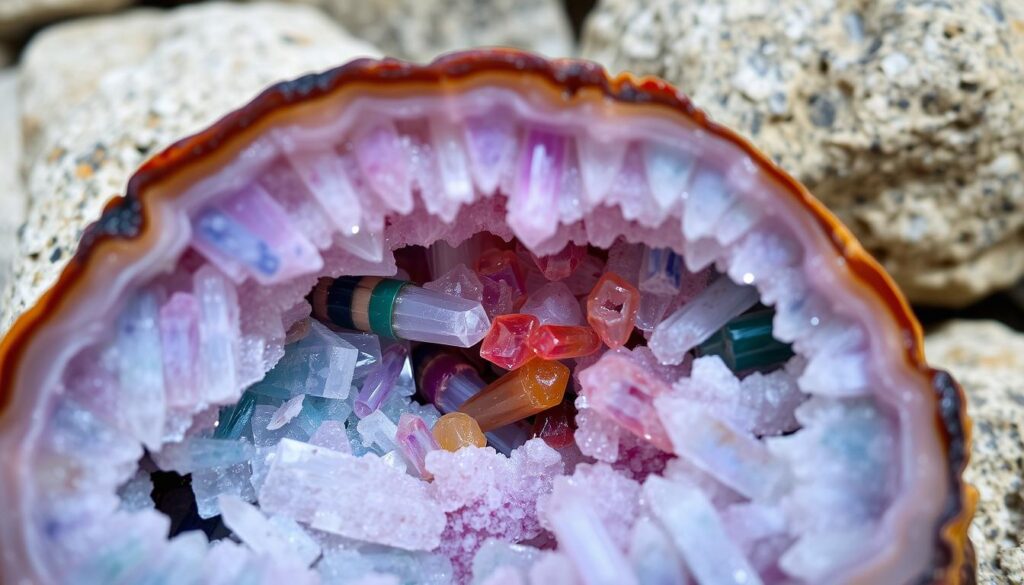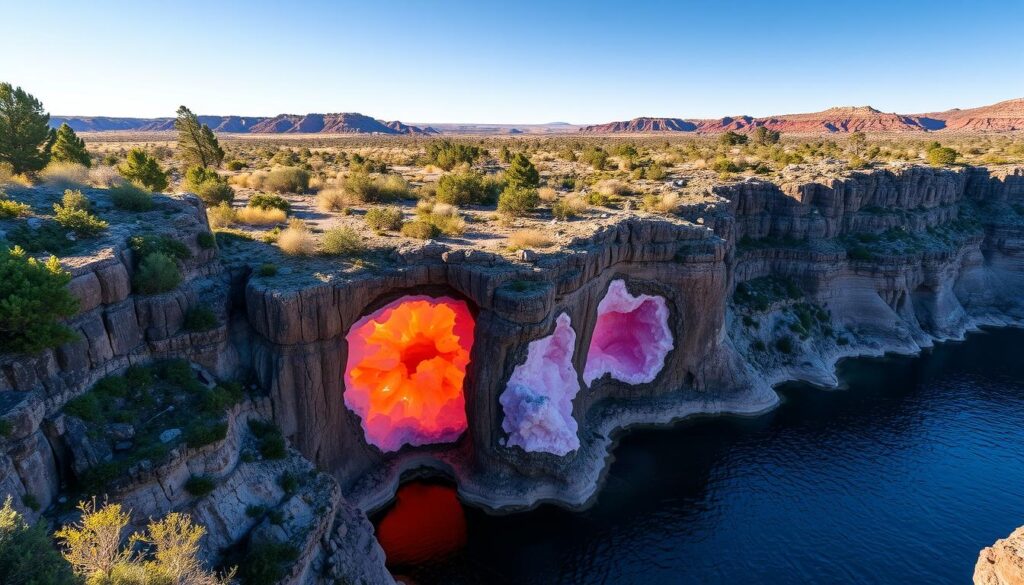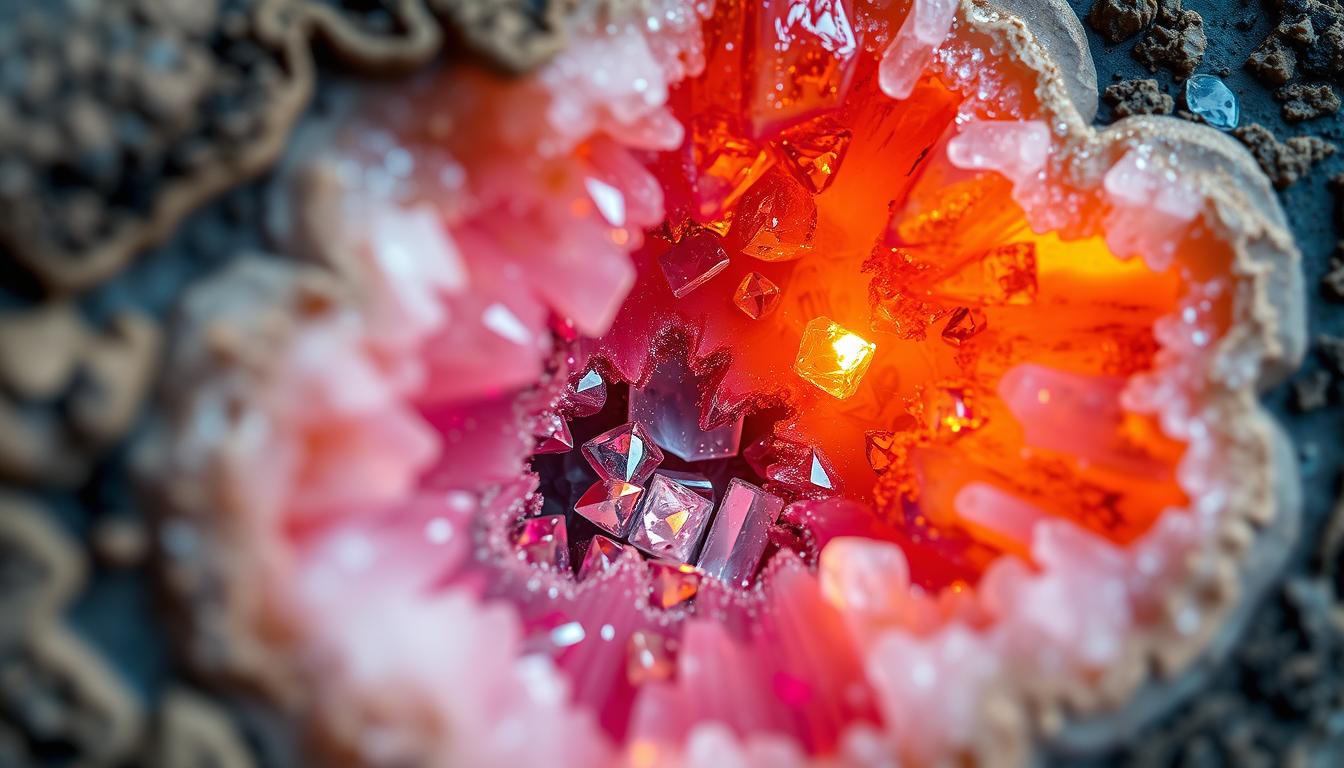This post contains affiliate links.
Ever wondered what wonders lie beneath the Earth? Geodes, nature’s secret crystal chambers, might be the answer. These geological curiosities are more than rocks; they’re treasure chests waiting to be opened.
Imagine holding a plain rock, then splitting it to reveal a world of crystals inside. That’s the magic of geodes! These mineral cavities form over millions of years, filling with sparkling crystals that light up in mesmerizing ways.
Whether you’re a budding geologist or just love nature’s art, geodes show Earth’s hidden beauty. From amethyst-lined chambers to calcite formations that glow, each geode has its own story of time and pressure.
Ready to start your own crystal-hunting adventure? With geode kits, you can explore these wonders at home. It’s not just about the thrill of discovery; it’s about connecting with Earth’s history in a beautiful way.
Key Takeaways
- Geodes are natural rock formations with crystal-lined interiors
- Each geode is unique, offering a surprise when cracked open
- Popular types include amethyst, calcite, and agate geodes
- Geodes are used in jewelry, home decor, and even healing practices
- Proper care and display can preserve geodes’ beauty for years
- Geode collecting can be a fascinating hobby for all ages
What Are Geodes and How Do They Form?
Geodes are nature’s hidden treasures. They are spherical rocks with hollow interiors filled with dazzling crystals. These rocks form through a fascinating process involving volcanic bubbles and mineral deposition.
The Science Behind Volcanic Bubble Formation
Geodes often start in volcanic environments. As lava cools, gas bubbles get trapped, creating hollow rocks. These rocks are perfect for crystal growth.
Mineral Deposition Process
Over thousands of years, groundwater seeps into these cavities, depositing minerals. This slow process leads to stunning crystal structures inside the geode. Quartz, amethyst, and calcite are common minerals found in these natural wonders.
Types of Host Rocks
While volcanic rocks are prime geode hosts, sedimentary rocks like limestone can also harbor these treasures. Animal burrows, mud deposits, and even tree roots can create spaces for geode formation in sedimentary environments.
| Host Rock Type | Common Locations | Typical Minerals |
|---|---|---|
| Igneous (Volcanic) | California, Arizona, Utah | Quartz, Amethyst |
| Sedimentary | Iowa, Missouri, Illinois | Calcite, Dolomite |
| Metamorphic | Brazil, Spain | Soapstone, Hematite |
The unique formation process of geodes ensures that each one is a one-of-a-kind masterpiece. They wait to be discovered and appreciated.
The History and Discovery of Geodes
Geodes have fascinated people for centuries. These crystal-filled wonders are found all over the world. Each find helps us learn more about Earth’s minerals.

Exploring geodes has taken people across continents and cultures. In North America, Mexico City is known for its geodes due to volcanic activity. The United States also has many geode deposits, in places like Indiana, Iowa, and Utah.
South America is home to some of the most stunning geode formations. Brazil and Uruguay are famous for their amethyst-filled geodes. These places, along with Namibia and Mexico, are key sources of geodes.
“Geodes are nature’s treasure chests, each one holding a unique crystal surprise.”
Europe also has its geode treasures. In England’s Mendip Hills, they call them “potato stones.” Spain’s Pulpi Geode, discovered in 1999, was the largest crystal cave at the time, measuring 8.0 by 1.8 by 1.7 meters.
Asia’s geode hotspots include Myanmar and the Himalayas. Geodes are found in many countries around the world. This shows nature’s creativity on a global scale.
Common Minerals Found in Crystal-Filled Nodules
Crystal-filled nodules, or geodes, are filled with stunning minerals. These formations surprise collectors with their beauty and variety. Let’s look at some common and rare minerals found in geodes.
Quartz Varieties
Quartz is a common mineral in geodes. It comes in several beautiful varieties:
- Amethyst: Purple quartz, hardness 7 on Mohs scale
- Citrine: Yellow to orange quartz, also 7 on Mohs scale
- Chalcedony: Microcrystalline quartz, comes in various colors
Calcite Formations
Calcite is another common mineral in geodes. It forms in many shapes and colors:
- White to colorless: Most common form
- Fluorescent: Glows under ultraviolet light
- Hardness: 3 on Mohs scale
Rare Mineral Occurrences
Some geodes contain rare and valuable minerals. These minerals are highly sought after by collectors:
- Celestine: Blue to white, 3-3.5 on Mohs scale
- Amazonite: Bluish-green, best quality found in Russia
- Bornite: Known as “peacock ore” for its iridescent colors
| Mineral | Color | Hardness (Mohs) | Notable Locations |
|---|---|---|---|
| Amethyst | Purple | 7 | South America, Africa |
| Calcite | Various | 3 | Worldwide in limestone |
| Celestine | Blue to white | 3-3.5 | Worldwide |
| Amazonite | Bluish-green | 6-6.5 | United States, Russia |
World-Famous Geode Locations
Geodes are loved by collectors all over the world. The United States is home to many places where you can find these amazing rocks.

In Iowa, the Keokuk Geode Beds along the Mississippi River are famous for their quartz-filled geodes. Utah’s Dugway Geode Beds are known for their quartz and mineral-rich geodes. Arizona’s Geode Hill in Tonto National Forest is known for its high-quality geodes with quartz, amethyst, and calcite.
California’s Mojave Desert is home to the Hauser Geode Beds, famous for their vibrant blue, purple, and green agate geodes. Kentucky’s Warsaw-Salem Formation near Bedford and Sulphur is known for its stunning quartz or calcite crystals in geodes.
Brazil is the top producer of amethyst, while Uruguay is famous for its agate geodes. Namibia’s deserts are known for their remarkable calcite geodes. Mexico is home to a wide variety of geodes, including fire agate.
| Location | Famous For | Notable Minerals |
|---|---|---|
| Keokuk, Iowa | Quartz Geodes | Clear Quartz |
| Dugway, Utah | Abundant Geodes | Quartz, Various Minerals |
| Payson, Arizona | High-Quality Geodes | Quartz, Amethyst, Calcite |
| Mojave Desert, California | Colorful Agate Geodes | Blue, Purple, Green Agate |
| Brazil | Amethyst Geodes | Amethyst |
How to Identify High-Quality Geodes
Finding top-notch crystal-filled nodules is an art. With a keen eye and some know-how, you can uncover nature’s hidden treasures. Let’s dive into the world of these fascinating hollow rocks and learn how to spot the best ones.
External Surface Features
The outer shell of a geode can tell you a lot. Look for a bumpy, cauliflower-like texture. High-quality geodes often have a rough, weathered appearance. The color might be dull, but don’t let that fool you – it’s what’s inside that counts!
Weight and Size Indicators
Pick up the geode. Does it feel lighter than you’d expect? That’s a good sign! The best crystal-filled nodules are often lighter due to their hollow interiors. Size-wise, geodes can range from walnut-sized to basketball-sized, with some giants reaching several feet across.
Testing Methods
Want to peek inside without cracking open your geode? Try these methods:
- Shake test: Gently shake the geode. A rattling sound might indicate loose crystals inside.
- Light test: Hold a bright light behind the geode. Some high-quality specimens might let a bit of light through, hinting at the crystal structure within.
- Tap test: Lightly tap the geode with a metal object. A hollow sound often suggests a crystal-lined cavity.
Remember, identifying top-tier geodes takes practice. As you explore different rockhounding locations, you’ll develop a knack for spotting these geological wonders. Happy hunting!
| Geode Type | Common Locations | Characteristics |
|---|---|---|
| Amethyst | Brazil, Uruguay, Mexico, Namibia | Deep purple color, varying cluster sizes |
| Agate | Worldwide | Polished spherical rocks, colorful bands |
| Citrine | Heat-treated amethyst geodes | Golden tones, unique formation |
| Texas Geodes | Coke, Fisher, Nolan counties | Calcite crystals, celestite, quartz varieties |
Safe Geode Cracking Techniques
Cracking open geodes is exciting, but it must be done carefully. We’ll look at safe ways to open these rock cavities. This way, we can enjoy the crystals inside without damage.
Required Tools and Safety Equipment
To safely crack geodes, you need the right tools and safety gear. A geode cracker or soil pipe cutter is best for opening geodes without harming the crystals. If you’re on a budget, a hammer and stone chisel or screwdriver can also work. Always wear safety goggles and gloves to avoid injuries from flying rock and sharp edges.
Step-by-Step Breaking Process
Here’s how to crack your geode:
- Work in a well-ventilated area
- Secure the geode in a vice or on a solid surface
- If using a geode cracker, slowly increase pressure until the rock splits
- For hammer methods, tap gently around the circumference until it cracks open
- Carefully separate the halves to reveal the crystals inside
Common Mistakes to Avoid
When cracking geodes, avoid these mistakes:
- Using too much force, which can shatter delicate crystals
- Not wearing safety gear, risking injury from rock shards
- Choosing the wrong tools for the job
- Ignoring the geode’s weight – lighter ones are more likely to be hollow
Remember, each geode is unique, formed over hundreds or thousands of years. Take your time to appreciate the fascinating geological processes that created these natural wonders. As you carefully reveal their hidden treasures, enjoy the journey.
| Cracking Method | Pros | Cons |
|---|---|---|
| Geode Cracker | Efficient, less damage to crystals | Specialized tool, may be expensive |
| Hammer and Chisel | Budget-friendly, widely available | Requires more skill, higher risk of damage |
| Slab Saw | Precise cuts, great for larger geodes | Requires lapidary equipment, not portable |
| Wet Tile Saw | Smooth cuts, water-cooled blade | Best for smaller geodes, needs power source |
Understanding Thunder Eggs vs Regular Geodes
Exploring geodic rocks, you’ll find amazing formations like thunder eggs and regular geodes. These rocks are loved for their unique looks and beautiful inside designs.
Thunder eggs got their name from Native Americans in Oregon. They are solid in the middle with a rhyolitic outer shell. They come in different colors, textures, and shapes. Regular geodes, by contrast, are hollow and filled with crystals. They start from sedimentary or organic materials.
In Sydney, you can find ironstone concretions because of the area’s iron-rich soil. Australia is full of places to find thunder eggs, like Mt Hay and Agate Creek in Queensland, and Boggabri in New South Wales.
Australia also has volcanic geodes filled with minerals like calcite and chalcedony. You can find them in Monto, Queensland, Narrabri, New South Wales, and along the lower Snowy River in Victoria.
| Feature | Thunder Eggs | Regular Geodes |
|---|---|---|
| Center | Usually solid | Typically hollow |
| Origin | Volcanic | Sedimentary or organic |
| Interior | Agate or chalcedony | Crystal formations |
Some thunder eggs have hollow centers, making them similar to regular geodes. Brazilian agates, for example, form in gas pockets in basalt or andesite. Discover top gem and mineral locations to see these wonders for yourself.
Collecting and Preserving Your Crystal Treasures
Keeping your geodes and crystals safe is important. You need to pay attention to how you store, clean, and display them. With the right care, your crystals can stay beautiful for many years.
Storage Solutions
Store your crystals in padded containers to avoid damage. About 40% of collectors have scratched their crystals by storing them with others of different hardness. A display cabinet is a good choice for 30% of collectors, as it keeps dust away and keeps your crystals safe.
Cleaning Methods
Cleaning your crystals gently is key. A big 70% of collectors clean their crystals in a 7-step process. For crystals like Selenite, which 15% of collectors buy, you need to be extra careful. Don’t let your crystals get wet, as 25% of collectors have seen them tarnish in damp places.
Display Options
Think about how much light your crystals get when you display them. About 20% of collectors say direct sunlight can make colors fade. Use stands or custom mounts to show off your crystals’ unique features. Remember, the right display not only makes your crystals look better but also keeps them safe. Collectors spend 10-20% of a crystal’s value on upkeep each year.
FAQ
What exactly are geodes?
How do geodes form?
What kinds of minerals can you find in geodes?
Where can you find geodes?
How can you identify a high-quality geode?
What’s the safest way to crack open a geode?
What’s the difference between thunder eggs and regular geodes?
How should you care for and display your geode collection?
Are geodes valuable?
Can you grow your own geodes?
This post contains affiliate links.

